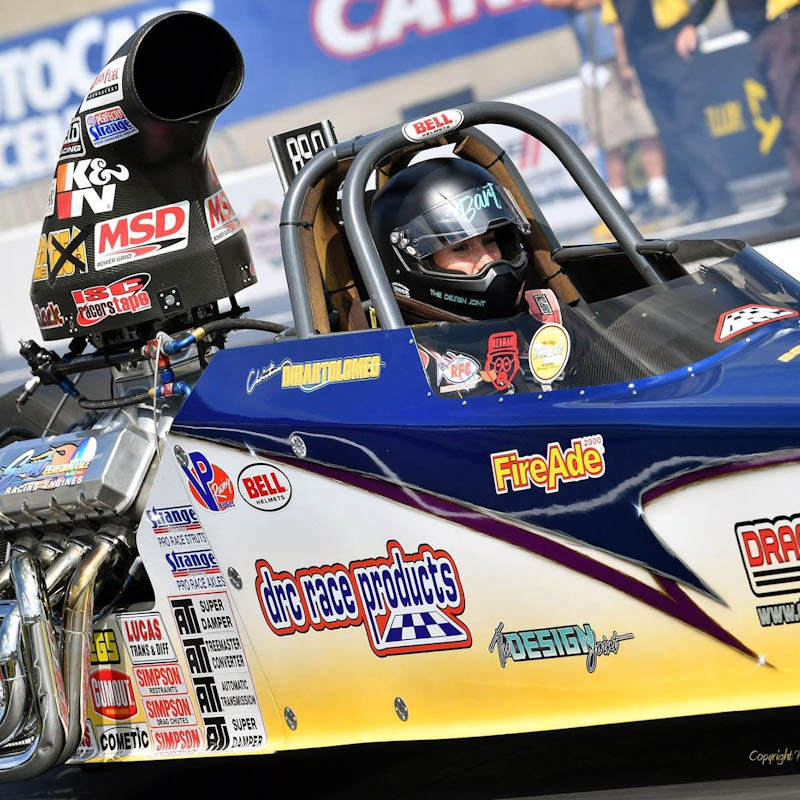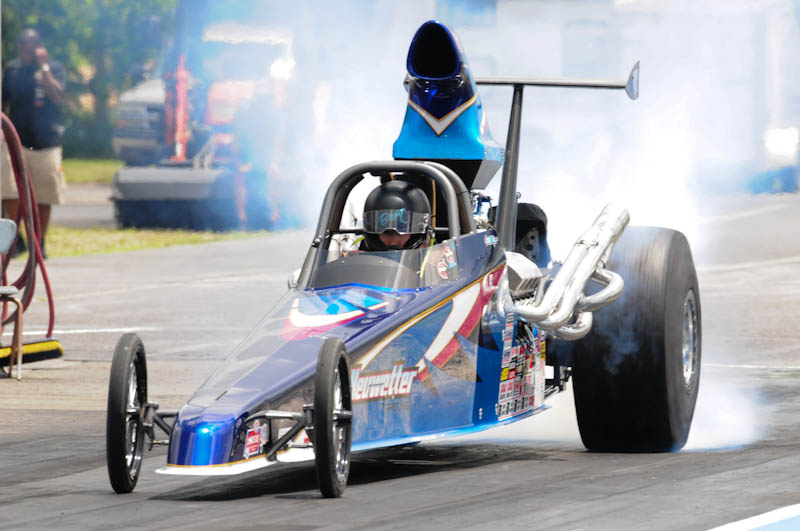OFF THE TRACK: RACER ON TARGET AS CORNHOLE PLAYER

 Should you ever wander through the pit area at an NHRA drag race and see Christina DiBartolomeo tossing bags at a cornhole board, just admire her work …
Should you ever wander through the pit area at an NHRA drag race and see Christina DiBartolomeo tossing bags at a cornhole board, just admire her work …
… because you don’t want any of that. Odds are strongly in her favor that she’ll whip your butt.
You don’t think so?
OK, be that way -- but don’t whine that you weren’t warned.
In the past year-plus, the 29-year-old DiBartolomeo has made the transformation from bemused, curious spectator of televised professional cornhole competition -- yes, there is such a thing as pro cornhole -- to dedicated aficionado. The Super Comp racer, whose on-track skills have taken a back seat lately for various reasons, is into the game of cornhole in a major way, competing in local, state and regional tournaments.
When she’s not focused on her graphics business, The Design Joint, in Beaver Springs, Pa., she’s scouring the area around home for cornhole tournaments almost every night of the week.
“How I started, I was actually just watching TV one day, right when COVID hit, and an ACL (American Cornhole League) thing was on,” she said. “They said ‘anybody could play,’ and I’m, like, ‘Anybody?’ So I found out who one of the directors was, I looked it up on Facebook, whatever -- did a little research -- and found out that they had these virtual cornhole tournaments during this COVID thing because no one could get around. So I set (boards) up in my dad's shop, and you have to put your measuring tape out (to ensure the boards are 27 feet apart, front to front) and everything.”
That’s when she discovered that tournament cornhole has significant differences from the game that’s played by friends and drinking buddies in the backyard or at a cookout.
The most important of those differences is that the bags used in competition aren’t filled with corn; in fact, it’s illegal.
“In the beginning, that’s all I had, so I used them,” DiBartolomeo said. “I didn’t think anybody could tell, and it wasn’t like I was trying to get away with something. It was a case of me not going out and spending $60, $70, $80 on a set of four bags.”
OK, then what’s inside the bags tossed by serious players?
A pro-quality bag is filled with pellets made of a polyresin. The bags have to measure between 5.75 and 6.25 inches, and must be between 1.25 and 1.5 inches in thickness. The bags have to weigh between 15.5 and 16.25 ounces.
Demand for the bags is high, which has led to a major price increase, she said, with some bags selling in the $300 range for a set of four. DiBartolomeo is partial to Pro Snipers and Shamrocks, which are made by Lucky Bags Cornhole. It’s akin to serious bowlers who own multiple balls, and they’ll choose which one to use at various times throughout a day or tournament based on current lane conditions.
 Once a player has his/her bags literally in hand, the game becomes even more intense. Take the throws, for instance: “There’s a ‘roll bag,’ ” she said, “there’s a ‘slide bag,’ there’s a ‘blocker,’ there’s a ‘push’ -- so many different kinds of throws.”
Once a player has his/her bags literally in hand, the game becomes even more intense. Take the throws, for instance: “There’s a ‘roll bag,’ ” she said, “there’s a ‘slide bag,’ there’s a ‘blocker,’ there’s a ‘push’ -- so many different kinds of throws.”
And -- drag racing tuners will appreciate this -- weather elements must be taken into account during competition. Humidity is a major factor in how a throw ends up.
“It’s like at racetracks and how you set the delay box in the racecar: ‘Hey, I’ve got to slow it down, I’ve got to take 20 out,” she said. “If you land a bag on the board and it flies off the back, you have to adjust. You have to adjust your throw to the climate, whether the sun’s beating on the boards -- that kinda stuff. A lot of people will show up and say, ‘Yo, how are the boards? Are they fast or slow today?’ ”
It’s crucial, she said, to get the first shot in a head-to-head duel. There have been instances, she added, where she’s been shut out by an opponent simply because the other player was the first to score the requisite 21 points.
In addition to the physical skill needed to nail the shot intended on a throw, there’s also the mental aspect of the game. Just as is the case with drag racing, there’s plenty of trash talking involved between rounds of competition.
“There's people intentionally trying to get in your head. A lot of people wear headphones or headsets,” DiBartolomeo said. “When I was at the USA Cornhole Club Championship qualifier, that was the first time I ever used headphones, and I'm not really sure if they worked or not. Because normally if someone tries to talk to me, I'll just ignore him -- like I didn't hear him or something. Most of the time you don't know if they're just trying to get in your head ... but that makes me mad when someone intentionally tries to do it.”
All the smack talk didn’t work when she took the No. 1 spot in the state’s Keystone USA Club Championship qualifier. And when it comes to the groups putting on events, cornhole is again much like drag racing in that there are multiple sanctioning bodies. In cornhole, there’s the aforementioned ACL, the American Cornhole Organization and the World Cornhole Organization. DiBartolomeo favors action under the auspices of ACL rules.
She’s also trying to add more cornhole-related work to her business offerings. The Design Joint offers graphic design, vinyl graphics, advertising materials, race-event flyers and more. She could advertise her cornhole wares at races, should she choose.
“I've been posting pictures of myself on Instagram and Facebook” from cornhole tournaments, she said, “and then when I’d go to the racetrack, they're like, ‘Oh, there's that cornhole girl. She comes to snipe everybody out.’ No one at the racetrack wants to play me for money.
“I don't really throw at home that often. I usually just bring my one wooden set to the racetrack. And then, Mondays, I travel 30 minutes to go to a free place, it's like a church. Tuesdays, I go down like an hour south of me that's a really popular place, and the competition is unreal there, unreal. There's another place that's 50 minutes down the road that's huge for me because I’m guaranteed six games for $15, and some pros come down there and throw just for fun.
“I go to a lot of local events, regionals. They have conferences, they have opens, they have nationals, they have shootouts.”
Competing in cornhole tournaments is far less costly than racing; a pittance by comparison. Racing, for obvious reasons, was her first love.
 DiBartolomeo started racing at age 8 in junior dragsters, but within a couple of years, “I didn’t really want to race. I was, like, ‘Yeah, it’s too hot.’ My brother was so upset with me. He was, like, ‘How could you say that?’ So we kept the junior for a year, then Dad
DiBartolomeo started racing at age 8 in junior dragsters, but within a couple of years, “I didn’t really want to race. I was, like, ‘Yeah, it’s too hot.’ My brother was so upset with me. He was, like, ‘How could you say that?’ So we kept the junior for a year, then Dad
sold it back to the guy.”
Within a couple of years, though, Christina DiBartolomeo was back behind the wheel in Teen Championship Racing, in which a child could drive a full-size car as long as there was an adult over age 25 in the car with them. Call it the equivalent of ‘drag racing driver’s education.’
Christina and Franklin grew up around the sport. Their dad, John DiBartolomeo, has multiple NHRA national-event victories to his credit.
“It’s been my life for 29 years,” she said. “My dad would build sleeper beds in the back of trucks, and we would travel everywhere for races … Florida, everywhere. My parents went to the racetrack with just the amount of money for the entry fee. My mom would work and sell, and then my dad would race. So that was what they did to balance their budget, I guess. They worked their asses off.”
By 16, she graduated to NHRA’s Stock Eliminator division, competing in a ‘70 Chevrolet Nova in the U and V/Stock Automatic ranks. That eventually led to a ride in a bracket car, then to a Super Comp dragster.
“The whole mindset of cornhole and racing is similar. It’s mind over matter. It’s all a mind game, cornhole and drag racing. When I get in the racecar, I don’t talk. People will ask me, ‘Are you mad?’ and I’ll say, ‘No, I’m in my own zone.’ I mean, I’m at work, y’know?”
Which activity is her priority? That’s not a question she can answer.
“Well, we haven't really been racing lately. My dad recently got sick and so he's trying to get better and everything,” she said. “So we haven't really been going to the racetrack lately, and I've been focused more on cornholes. He's just, like, ‘Hey, you're doing really good. Just keep doing that.’ ”





































